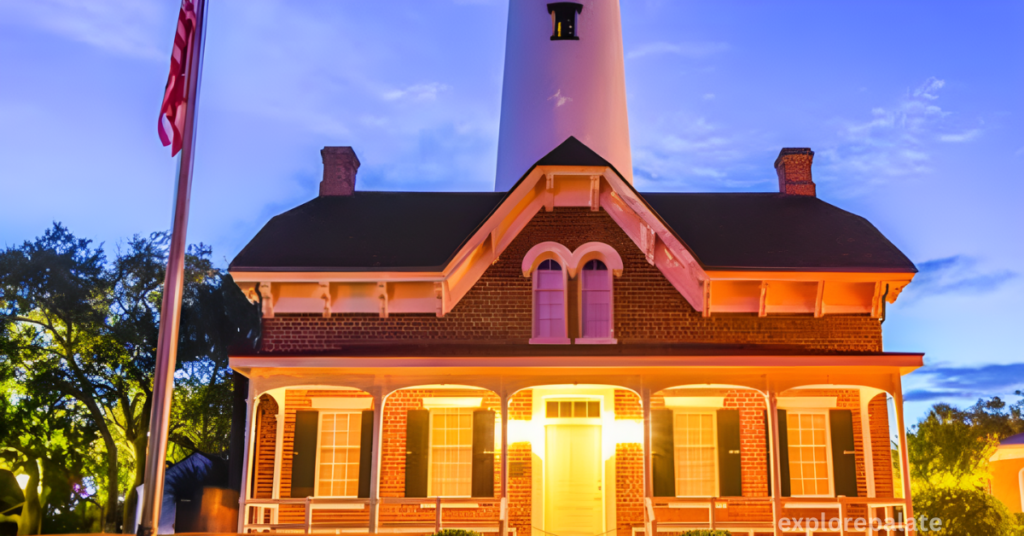The First African Baptist Church on St. Simons Island, Georgia, is not just an architectural marvel but a beacon of hope and history. Founded in 1859, this two-story frame structure with its distinctive front gable building and shingle siding has stood the test of time. Remarkably featuring round arch windows and an off-center entrance leading to a pyramidal roof and steeple, the church was built primarily in 1869 by former slaves from the St. Simons plantations. It is here that a congregation was first organized nearly ten years after the church’s founding, solidifying its place as a pivotal African American church in the region.
As someone who has traveled across the island, I have often felt a sense of awe passing by this church that I knew had been a place for worship services every Sunday. The distance that some members had to cover, especially those who resided on the south end of the island in the late 1800s, could not stifle their devotion. They established mission churches around the island to better serve the spiritual needs of their community.
Notably, the church doesn’t give tours but, it still holds services at 11 am and once a year, reads the entire history of the Church, including all important events and additions to the building, like the acquisition of electricity in the 1950s. The written history, spanning over five pages, is a testament to a past much longer than many other historic sites and is often overlooked in tourism books and brochures. Yet, it is a lovely part of our culture.
Visitor Information: Honoring Ancestors with Every Visit

As a beacon of heritage, the First African Baptist Church holds a unique place as the oldest Black church on the Island. An important symbol of the rich religious history of St. Simons Island, there’s no shortage of significance here. Despite the establishment of numerous churches in the early 1800s, the importance of this particular church cannot be overstated.
Religion played a key role in the founding and development of St. Simons and provided spiritual strength to its religious communities. This foundation was significant as the congregation was founded and built by the slaves of the plantations. The members originally worshipped in a tabby church located in the servants’ quarters of the West Point Plantation, before the current church was built in 1869.
For over 163 years, this church has not only fulfilled its mission by meeting the needs of its members, but it has also become a cherished tourist destination within the Golden Isles. Visiting this lovely part of our culture is a sobering reminder of the endurance of faith and community.
While the church does not give tours, it holds services at 11 am, and once a year, it reads the entire history of the Church, including important events like the additions to the building and the acquisition of electricity in the 1950s. This history, which encompasses much more than just five pages, is a crucial piece in understanding not only the church but the island’s heritage. Although not as prominent in tourism books and brochures, this historic site is in better condition than many and just as deserving of recognition for its integral role in the tapestry of American history.
Conclusion
The First African Baptist Church on St. Simons Island stands as a profound symbol of resilience, faith, and history. It is remarkable not only for its architectural integrity but also for the rich legacy it represents—built by former slaves, it has been the spiritual epicenter for the African American community on the island for over 163 years. Beyond its weekly worship services and annual historic readings, this church offers a quiet testament to the enduring spirit and dedication of its congregation.
The lack of commercialization in the form of tours only adds to its reverence, maintaining its sanctity and focus as a place of worship. Although it may not feature prominently in tourist literature, its significance to America’s fabric is immeasurable, echoing the strength of community and the power of faith through the centuries, making every visit an honor to the ancestors who founded and sustained it.
You Might Also Like
FAQs
Why is St. Simon’s Island famous?
Located across the Marshes of Glynn, the Island is the largest barrier island in the Golden Isles. Although mostly famous for its pristine beaches and warm temperatures, St. Simons Island offers many activities and attractions to enjoy along with its distinct southern charm.
Who started the First African Baptist Church?
Since it was organized in 1773 by Reverend George Leile, the church even predates the United States’ official formation in 1776.
What is the oldest African American church?
The slaves Peter Durrett and his wife founded the First African Church (now known as First African Baptist Church) in Lexington, Kentucky about 1790. The church’s trustees purchased its first property in 1815. The congregation numbered about 290 by the time of Durrett’s death in 1823.
In what year was the First African Baptist Church established on Sapelo Island?
1899-1900 and is the last surviving remnant of the Raccoon Bluff community, once the largest community on Sapelo Island. It was added to the National Register of Historic Places in 1996. NRHP reference No. The congregation was founded in 1866 and was the only church congregation on Sapelo Island until 1884.
What was the significance of St Simon?
Saint-Simon created a political and economic ideology known as Saint-Simonianism that claimed that the needs of an industrial class, which he also referred to as the working class, needed to be recognized and fulfilled to have an effective society and an efficient economy
What is interesting about Saint Simon?
He supposedly preached the Gospel in Egypt and then joined the apostle St. Judas (Thaddaeus) in Persia, where, according to the apocryphal Acts of Simon and Judas, he was martyred by being cut in half with a saw, one of his chief iconographic symbols (another being a book).




